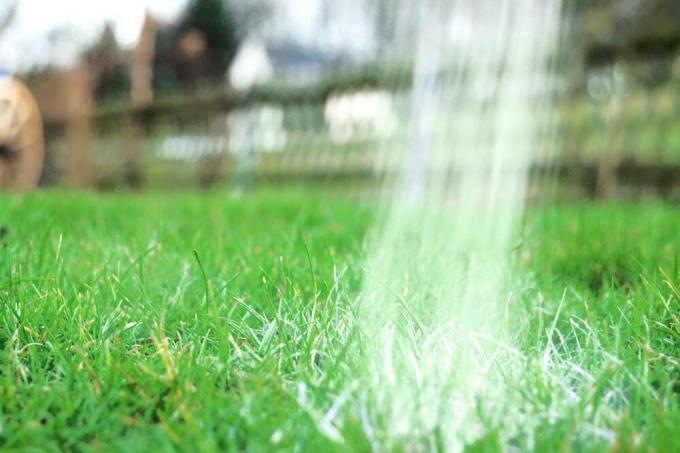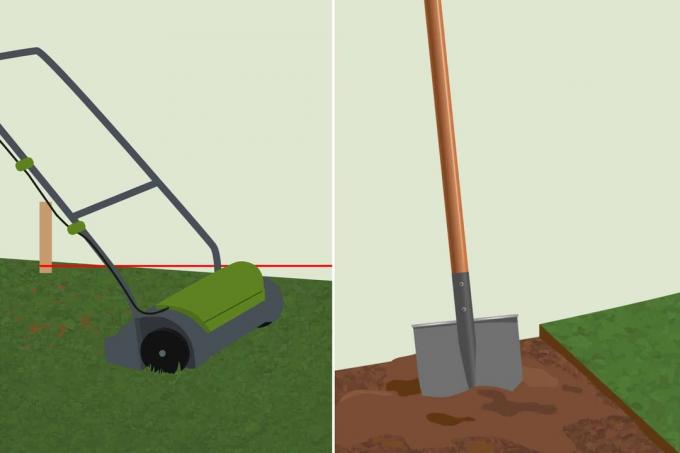

Table of contents
- prevention
- blue grain
- cola
- Vinegar
- coffee grounds
- lime
- Light
- Salt
- sand
- baking soda
- rake
Scarifiers, blue grain, coffee grounds, lime, vinegar and Co. are recommended household remedies or measures for removing moss in the lawn. But what really helps and what can do more harm?
prevention
The best way to keep the meadow moss-free is to prevent unwanted growth. This can be achieved through several measures and means:
Regular mowing
When the lawn is kept short and mowed regularly, the grass plants become denser and both weeds and mosses have less of a chance of growing in between. You should therefore mow at least once a week during the gardening season.
Adjusted fertilizing
Strong lawn plants let weeds and moss through less. Appropriate fertilization during the growth phase is therefore crucial for preventing mosses.
scarify
When scarifying, sharp blades are pulled through the bottom of the lawn. On the one hand, this cuts through the roots, which stimulates renewed growth. On the other hand, the soil is loosened and the mosses are torn out. This allows water and nutrients to penetrate better. This in turn also contributes to the good supply of the plants and can not only prevent moss infestation.
blue grain
Blue grain fertilizer is a chemical agent. Unfortunately, this can have an irritating effect and may therefore only be used in such a way that neither people nor animals have direct contact with it. After spreading, the lawn should therefore be well watered and not walked on for a few days. The fertilizer does not help against mosses directly, but only by strengthening the grass plants.
cola
Cola is always recommended as a home remedy for moss. However, this product should only be used on surfaces that can be cleaned and rinsed. For example on stone slabs or on moss-covered walls.
Vinegar
A dilution of vinegar and water will acidify the soil, but not only can this solution damage the grass, it can actually encourage moss growth. Because mosses thrive very well on acidic soil.
Tip:
Tip: Moss-covered surfaces - such as paving slabs - can be cleaned very well with diluted vinegar essence or milder types of vinegar clean when the solution is applied to the affected areas and brushed and rinsed off after a few hours exposure becomes.
coffee grounds
The dry remains of the morning coffee have several advantages as a home remedy for preventing and destroying moss. These are:
- biological and readily degradable
- cheap
- non-toxic
- has a fertilizing effect on the grass plants

A disadvantage, however, is that the moss infestation is not directly combated by the coffee powder, but only the grass is fertilized and thus strengthened.
lime
Mosses grow less well on alkaline soil. Therefore, calcareous fertilizer is well suited for removing moss, as it increases the pH value of the substrate. It is important here:
- uniform application, for example by a spreader
- Thoroughly water or blast the meadow afterwards
- Ideally, scarify the grass beforehand so that lime and water can penetrate better
Light
Mosses grow primarily in dark, poorly lit areas. If the meadow is shaded by hedges, trees, other plants or buildings, or if there is clippings on it, the conditions for moss growth are ideal. As a countermeasure, we recommend trimming the larger plants or regular care of the affected areas to prevent the moss from spreading. In addition, there should be no waste
Salt
Salt is often used so that, for example, weeds can be controlled in a targeted manner. Because it is inexpensive and easy to use. The problem with the use, however, is that the soil becomes salty, which is also harmful to the lawn and all other plants. If you want to get rid of mosses but don't want to damage the garden permanently, you should therefore avoid this home remedy or only use it on paths and not on the meadow.
sand
Using sand against mosses in the meadow may seem strange at first, but it is one of the simplest, cheapest and most efficient methods to keep the disturbing plants permanently removed. The procedure is also simple:
- Mow grass short and blast.
- Fill construction sand into a spreader.
- Set the output regulation of the spreader as far as possible.
- Distribute the sand so that only the tips of the blades of grass are visible after it has been dispensed. Alternatively, you can also drive across the meadow several times.
Since moss plants thrive best in damp areas and clayey soil, they are suffocated by the dry sand. In addition, sand can help to loosen the soil permanently and thus promote the growth of grass roots and strengthen the plants as well as curbing the growth of moss.
baking soda

rake
If you don't want to buy or rent a scarifier to get rid of the moss layer, you can also use a simple rake or a garden claw. However, it is very tedious to remove the unwanted plants by hand. In addition, the plants can usually not be completely destroyed with it. However, this variant can certainly be selected for smaller areas.
 garden editorial
garden editorial I write about everything that interests me in my garden.
Learn more about lawn care

Leveling out unevenness in the lawn: this is how it works
Unevenness in the lawn is annoying and poses a danger to gardeners, playing children and pets. There are a number of methods that can be used to level the lawn. We present them to you in our guide.

Leveling the lawn: how to smooth uneven surfaces
Dents and holes in the lawn are unsightly. We will show you step by step how to smooth uneven areas in the lawn again.

Algae in the garden | Lawn is slippery: what to do?
Algae love rainy days. Can the water seep badly into the ground, even better! The green, slippery mass is not only not a pretty sight, but also a danger for the lawn. Only those who act preventively and correctly in acute cases can avoid permanent damage.

Fighting fungi in the lawn | 10 tips against fungal infestation
Mushrooms in the lawn are not uncommon but annoying and sometimes even dangerous. This is especially true if the garden or green space is also used by pets and children. Here we will show you how to combat fungal infestation.

Aerate the lawn | Before or after mowing?
Sun, water, fertilizer and air are necessary for the lawn to grow. If the lawn does not get enough air, it cannot grow properly. We clarify when the right time to ventilate the lawn is.

Mulching with lawn clippings: 13 things to consider
Keeping the lawn short is a must for many hobby gardeners. However, if the lawn mower does not have a mulching function so that the grass clippings can remain on the lawn, the question arises as to where to put the waste. Because the compost heap is not a good solution here.


